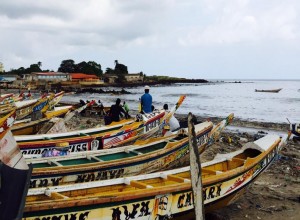 The Canary route
The Canary route
It’s hard to believe that this picturesque fishing village in Senegal is connected with the refugee crisis unfolding across Europe. But just 10 years ago, the village of Kayar was one of the main departure points for West Africans attempting the dangerous journey to Spain’s Canary Islands.
On its soft white beach, hundreds of young men would gather to pile into brightly painted wooden fishing boats. They were prepared to risk their lives for the chance of a better future.
“Europe or die, we told each other. Everyone here wanted to get away, everyone,” says Mor Mbengue, a fisherman who was 23 years old when he left in the middle of the night in August 2006. With 74 others, he climbed aboard an old boat filled with cans of petrol and food for the 1,500km journey to the Canary Islands: the gateway to Europe. Mor and his friends were born fishermen. They grew up playing in the waves and knew well how to handle the rough sea. But some of the other passengers had no experience with the water.
“When there is no fish, there is not much to do around here.“
“Some were convinced they could walk on water,” he says. “We had to tie them up to prevent them from jumping overboard.” In 2006, the number of West Africans trying to reach Europe peaked. More than 30,000 left from Senegal and neighbouring countries like Guinea, Mali, Nigeria, the Ivory Coast and Ghana that year.
“Their engine might have stopped working at some point, leaving them floating on open water endlessly, lost and never found again,” says Mor.
On the Canary Islands, Europeans watched as the rickety fishing boats came ashore; their passengers dehydrated, hungry and burned from days under the harsh sun. They were confused but euphoric at having made it.
Alarmed, Spain called for help from the European Union (EU). In July 2006, its border agency, Frontex, began boat and aircraft patrols of the seas. Those caught were either turned back towards the West African coast or repatriated by plane.Frontex refers to the mission as the “birth of sea operations”.
By 2008, the Canary route to Europe had been completely sealed off.
Now, 10 years after it reached its peak, many West Africans still dream of Europe. And some still attempt to make it. But now, they must take a different route: heading north towards Libya or Algeria, via Bamako in Mali, Ouagadougou in Burkina Faso and Agadèz in northern Niger before crossing the Mediterranean Sea to Italy. They often begin their journey independently, travelling on public transport, but the farther north they go, the more dependent upon smugglers they become.
“The route has changed, but the flow of migration did not.“
“It was only when the European border agency Frontex and the Spanish civil guard sealed off the Canary route that the Sahara route came into prominence,” explains Jo-Lind Roberts, the head of the International Organization of Migration office in Senegal. “The route has changed, but the flow of migration did not.”
In 2015, 6,000 Senegalese newcomers were registered in Italy, making them one of the five most represented nationalities among those arriving in the country – a high number for a country that has not known war since its independence in 1960.
“Obviously, it’s very different from leaving a conflict or war zone. But here in Senegal and other Western African countries, I believe it’s a combination of high unemployment and this image of Europe as some kind of paradise where you will be able to find a job really quickly,” says Roberts.
The sea is empty
“One, two, three! Power! Strength!” A group of men pull a heavy boat out of the water onto the sand. The fishing nets on board are almost empty.
Twenty-three-year-old twins Ousseynou and Assane Mbaye watch their fellow fishermen from a distance. Their boat lies untouched and half-buried in the sand, next to hundreds of other fishing boats lined up along the beach of Kayar.
“You work very hard for very little,” says Ousseynou, a matchstick serving as a toothpick between his teeth. “You get up very early in the morning, and you’re just never sure if you will catch any fish.”
“The sea is empty,” adds his brother Assane. “We have to look elsewhere for jobs.”
The Senegalese exodus in 2006 has often been associated with the crisis in the Senegalese fishing industry. For years, the fish stock has been declining because of overfishing and illegal fishing by foreign trawlers. According to a 2006 United Nations report, overfishing has led to 80 percent unemployment in the fisheries sector.
Some of those who didn’t make the crossing were able to put their wooden boats to a use other than fishing – becoming captains in the lucrative smuggling business.
Aly Tandian, a sociologist leading a migration research group at Gaston Berger University in Saint Louis, Senegal, says not much has changed since 2006, apart from routes people travel. “Young people still feel forced to leave to provide for their families, and they are willing to take a lot of risks doing so.”
“Senegal has a long historical tradition of migration,” says Tandian. “If you can’t find a job close to home, you look elsewhere.”
A recent study commissioned by the European Commission reveals that nearly three-quarters of Senegalese youths say they want to leave Senegal within five years.
Unlike other emerging African countries, Senegal has struggled for years with disappointing growth figures. According to the World Bank, “over the last decade, growth in Senegal averaged only 3.3 percent since 2006”.
‘Don’t go to Europe’
The boat Mor sailed to the Canary Islands on was called Seydina Limamou Laye, named after a Senegalese Muslim religious leader who was supposed to protect them from the dangers of the sea.
After more than a week, their boat finally reached an island. Mor remembers how blue the Mediterranean Sea looked on the day they came ashore in Europe.
All 75 on board had survived. They were ecstatic.
But their happiness didn’t last for long: After being picked up by the Spanish authorities in Las Palmas, the capital of the island of Gran Canaria, the majority of passengers were put on a plane and sent back to Senegal. One thousand villagers from Kayar – one out of every 20 residents – tried their luck in the Canary exodus in 2006. Some didn’t survive the journey. Half were sent back. Others were lucky and found a way to stay in Europe.
“All they know is that they want to leave to find work elsewhere.“
Now, Mor tries to convince the younger fishermen in his village not to go to Europe.
“Risking your life through the desert to Libya, [then] on a boat to Italy, only to get sent back again? Don’t do it,” he says.
But the young fishermen of Kayar don’t want to listen.
“The new generation did not experience the Canary Island exodus like we did,” says Mor. “All they know is that they want to leave to find work elsewhere.”
Share on Twitter
Fleur Launspach
Additional reporting
Saskia Houttuin
